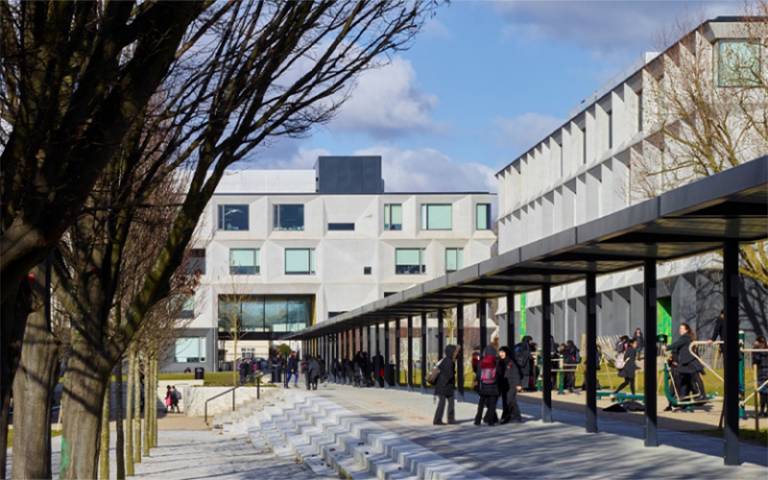Improving air quality in schools through better building design
Pioneering studies on indoor air quality in schools at UCL Bartlett have raised industry design standards and helped reduce pupils’ and teachers’ risk of respiratory and cardiovascular diseases.

28 April 2022
School is the most important indoor environment for children outside of the home. Poor air quality is linked with negative impacts for children’s health, absenteeism and academic performance. Studies have shown that air quality in school buildings can often fall below World Health Organization (WHO) standards.
Researchers at UCL Bartlett’s Institute for Environment Design and Engineering (IEDE) have set out to change this.
Through three major studies, the researchers have explored how factors such as building design, ventilation and temperature can affect student health outcomes. The findings of these studies have led to improvement to school air quality and industry standards in the UK and elsewhere.
A cost-effective alternative to mechanical ventilation
The ‘Ventilation in Schools’ project, led by Professor Dejan Mumovic, showed that natural ventilation systems can provide a cost-effective alternative to mechanical ventilation whilst maintaining air quality standards in schools. These findings were used to influence regulation for ventilation in schools set out in UK Department for Education’s ‘Building Bulletin (BB) 101: Ventilation’.
Adherence to these guidelines is mandatory for all schools built or refurbished through the UK government’s £4.4 billion Priority School Building Programme which is currently improving 537 of the nation’s worst school buildings. Each of these schools will now use natural ventilation, saving operational costs whilst maintaining air quality.
Professor Mumovic was later commissioned by the Mayor of London’s Office to investigate air pollution in London’s schools, resulting in the report ‘Indoor Air Quality in London’s Schools’; an audit of indoor school air pollution across London’. This report was published through the Mayor’s Office and accompanied by a £1 million fund to help the worst affected schools in London.
Raising standards in Europe and beyond
The School Indoor Pollution and Health: Observatory Network In Europe’ (SINPHONIE) project saw IEDE researchers teaming up with experts from 27 European countries to explore relationships between air quality factors including contaminants, temperature and ventilation and health outcomes such as airways, eye and systemic disorders.
Findings were used to develop SINPHONIE’s Guidelines for Healthy Environments within European Schools. This important document has been translated into 25 languages, and sections of the guidelines have been adopted by EU member states in their school planning approaches, thereby equipping policymakers to improve air quality in their school design plans.
With Tsinghua University, IEDE researchers worked on ‘Total Operational Performance of Low Carbon Buildings in UK and China’ (TOP). This work explored how to achieve high air-quality in low-carbon building design. With industry partner Eltek, the team developed an advanced air quality monitor, AQ110 to monitor pollutants, thermal comfort and ventilation rates.
Working with the UK building and design industry
AQ110’s results were used to define industry standards through the Chartered Institution of Building Services Engineers’ (CIBSE) design guides TM64 and TM61. CIBSE is the standard setter and authority on UK building services engineering, and its guides and codes set the criteria for best practice internationally.
Changes to these guides were part of extensive on-going work by Professor Mumovic to improve industry standards on school air quality, which also include his founding of the ‘CIBSE School Building Design Group’ with over 10,000 members across the globe.
Finally, a knowledge transfer partnership between IEDE and Ventive, a London-based low-energy ventilation systems company to design more effective ventilation systems paved the way for new indoor air quality systems and improved ventilation in over 40 schools, providing cleaner air for more than 8,000 pupils.
Research synopsis
Improving air quality in schools in collaboration with policymakers and industry
Three pioneering studies into indoor air quality in schools conducted at the UCL Bartlett’s Institute for Environment Design and Engineering (IEDE) have provided the evidence needed to improve school design and define best practice amongst building engineers and industry partners. Together these changes have improved school air quality, reducing the potential risk of respiratory and cardiovascular diseases like asthma among pupils and teachers.
Research team: Dejan Mumovic, Esfand Burman, Anna Mavrogianni, Clive Shrubsole, Hector Altamirano Medina, Michael Davies and Samuel Stamp
Links
- Professor Dejan Mumovic’s academic profile
- Dr Esfandiar Burman's academic profile
- Dr Anna Mavrogianni's academic profile
- Dr Hector Altamirano Medina's academic profile
- Professor Michael Davies' academic profile
- Dr Samuel Stamp's academic profile
- UCL Institute for Environmental Design and Engineering
- The Bartlett, UCL Faculty of the Built Environment
- The Bartlett REF 2021
Image
- Image credit: Tim Soar
 Close
Close

